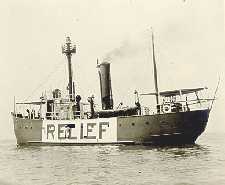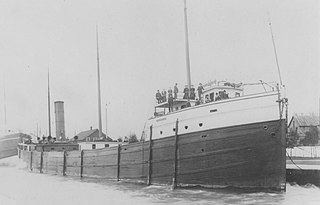
USS Michigan was the United States Navy's first iron-hulled warship and served during the American Civil War. She was renamed USS Wolverine in 1905.

Lake freighters, or lakers, are bulk carrier vessels operating on the Great Lakes of North America. These vessels are traditionally called boats, although classified as ships. Freighters typically have a long, narrow hull, a raised pilothouse, and the engine located at the rear of the ship.

The United States lightship Huron (LV-103) is a lightvessel that was launched in 1920. She is now a museum ship moored in Pine Grove Park, Port Huron, St. Clair County, Michigan.

SS Badger is a passenger and vehicle ferry in the United States that has been in service on Lake Michigan since 1953. Currently, the ship shuttles between Ludington, Michigan, and Manitowoc, Wisconsin, a distance of 62 miles (100 km), connecting U.S. Highway 10 (US 10) between those two cities. She is the last coal-fired passenger vessel operating on the Great Lakes, and was designated a National Historic Landmark on January 20, 2016.

SS Keewatin is a passenger liner which once travelled between Port Arthur/Fort William on Lake Superior and Port McNicoll on Georgian Bay in Ontario, Canada. She carried passengers between these ports for the Canadian Pacific Railway's Great Lakes steamship service. Keewatin also carried packaged freight goods for the railway at these ports.

The Georgian Bay Line is the popular name of the Chicago, Duluth and Georgian Bay Transit Company. From 1913 until 1967, the Georgian Bay Line (GBL) provided transit service and cruise voyages to passengers on North America's Great Lakes.

Steamer South American was a Great Lakes steamer built by the Great Lakes Engineering Works at Ecorse, Michigan. It was built in 1913/14 for the Chicago, Duluth & Georgian Bay Transit Company. The vessel was launched on February 21, 1914 and was the newer of two near-sister ships, the older one being the North American.

The SS Regina was a cargo ship built for the Merchant Mutual Line and home ported in Montreal, Quebec. Named after Regina, Saskatchewan, Regina had a tonnage of 1,956 gross register tons (GRT) and a crew of 32.

The history of commercial passenger shipping on the Great Lakes is long but uneven. It reached its zenith between the mid-19th century and the 1950s. As early as 1844, palace steamers carried passengers and cargo around the Great Lakes. By 1900, fleets of relatively luxurious passenger steamers plied the waters of the lower lakes, especially the major industrial centres of Chicago, Milwaukee, Detroit, Cleveland, Buffalo, and Toronto.

SS Ira H. Owen was a steel-hulled American lake freighter in service between 1887 and 1905. One of the first steel lake freighters, she was built in 1887 in Cleveland, Ohio, by the Globe Iron Works Company, and was built for the Owen Line of Chicago, Illinois. Early in her career, Ira H. Owen carried iron ore from Escanaba, Michigan. In April 1898, Ira H. Owen was chartered by the Baltimore & Ohio Railroad. She was sold to the National Steamship Company of Chicago, on December 30, 1899, for whom she frequently carried coal and grain. Throughout her career, Ira H. Owen was involved in multiple accidents and incidents.

SS Amasa Stone was a 545-foot (166 m) Great Lakes freighter that was sunk as a breakwater in 1965, Charlevoix, Michigan. She was built for the Mesaba Steamship Company by the Detroit Shipbuilding Company of Wyandotte, Michigan. She was launched on March 25, 1905, as hull #158. She was powered by an 1,800-horsepower (1,300 kW) triple expansion steam engine and two scotch marine boilers.

Iosco was a Great Lakes freighter that served on the Great Lakes from her construction in 1891 to her foundering on September 2, 1905, when she and her tow, the schooner barge Olive Jeanette sank on Lake Superior. While Olive Jeanette's wreck was located in over 300 feet (91 m) of water about eight miles (13 km) off the Huron Islands in the 1990s, Iosco's wreck has not yet been found.

The SS Atlanta was a wooden hulled Great Lakes steamer that sank in Lake Michigan off the coast of Cedar Grove, Wisconsin, United States, after a failed attempt of her being towed to shore ultimately killing 5 out of her 7 crew members on board. Her wreckage still remains at the bottom of the lake, and on November 6, 2017, the wreck of the Atlanta was listed on the National Register of Historic Places.

SS Selah Chamberlain was a wooden-hulled Great Lakes freighter that sank in Lake Michigan in 1886, 6 miles (10 km) off the coast of Sheboygan, Sheboygan County, Wisconsin, United States after being rammed by the steamer John Pridgeon Jr. with the loss of five lives. On January 7, 2019, the wreck of Selah Chamberlain was listed on the National Register of Historic Places, and was given the reference number 100003288. She was the first shipwreck listed on the National Register of Historic Places in 2019.

SS Russia was an iron-hulled American Great Lakes package freighter that sank in a Lake Huron gale on April 30, 1909, near DeTour Village, Michigan, with all 22 of her crew and one passenger surviving.

SS Merchant was an American iron–hulled passenger and package freighter in service between 1862 and 1875. The first iron–hulled merchant ship built on the Great Lakes, she was built in 1862 in Buffalo, New York, by the David Bell shipyard, out of components manufactured in Black Rock, New York, and Philadelphia, Pennsylvania. She was built for James C. and Edwin T. Evans of Buffalo, under whom she carried passengers and freight. Merchant made her maiden voyage in August 1862, sailing from Buffalo to Chicago. Between late 1872 and early 1873, she was lengthened by 30 feet (9.1 m), and had her passenger cabins removed. Also in 1873, Merchant was sold to the Erie & Western Transportation Company of Erie, Pennsylvania.

SS John Mitchell was a steel-hulled, American lake freighter in service between 1907 and 1911. She was built in 1906 by the Great Lakes Engineering Works in St. Clair, Michigan, for the Cornell Steamship Company of Chicago, Illinois, which was managed by C.W. Elphicke. She entered service in 1907, and had a sister ship named William B. Davock. Throughout her career, John Mitchell carried iron ore and coal. On October 4, 1908, she ran aground at Indiana Harbor, Indiana, while loaded with iron ore.

SS Manasoo was a steel-hulled Canadian passenger and package freighter in service between 1888 and 1928. She was built in 1888 in Port Glasgow, Scotland, by William Hamilton & Company for the Hamilton Steamboat Company of Hamilton, Ontario, who used her as a passenger transport between Hamilton and Toronto, Ontario. Macassa was lengthened in Collingwood, Ontario, in 1905. She was sold twice before being sold to the Owen Sound Transportation Company, Ltd., and was rebuilt and renamed Manasoo; after the sale, she mainly operated between Sault Ste. Marie and Owen Sound, Ontario.

SS Chester A. Congdon was a steel-hulled American lake freighter in service between 1907 and 1918. She was built in 1907 by the Chicago Shipbuilding Company of South Chicago, Illinois, for the Holmes Steamship Company, and was intended to be used in the grain trade on the Great Lakes. She entered service on September 19, 1907, when she made her maiden voyage. In 1911, Salt Lake City was sold to the Acme Transit Company. A year later, she was transferred to the Continental Steamship Company, and was renamed Chester A. Congdon, after lawyer and entrepreneur Chester Adgate Congdon. She was involved in several accidents throughout her career.



















